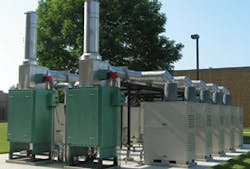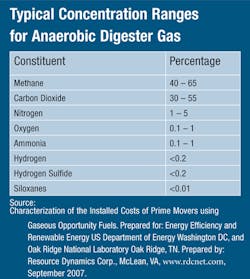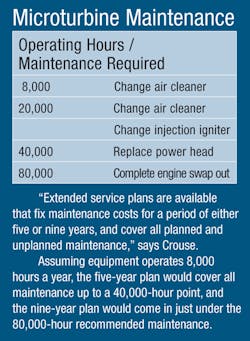Wastewater treatment plants are looking for ways to utilize the biogas they produce to generate their own power and heat while reducing their methane emissions. Possibly creating a closed loop, where both the offsite electricity and methane emissions become obsolete.
Methane is generated in the anaerobic digester, a solids management system that reduces both the volume and toxicity of sludge. Sludge originates in the plant’s primary and secondary clarifiers, where microorganisms consume bacteria under aerobic conditions and then settle out, respectively. Waste-activated sludge from the secondary clarifier is a slurry, at 2–4% solids, and requires additional treatment or disposal.
According to a November 2008 study by BCC Research, the North American and international market for sludge treatment is growing. One method of treating waste-activated sludge is anaerobic digestion, where sludge is processed into methane, carbon dioxide (CO2), and nutrient-laden solids that can be suitable as soil amendments.
The process is this: Anaerobic digester vessels are airtight and maintained at a biologically comfortable 90+˚F. Initially, organics in the sludge are converted to volatile fatty acids. Next, methane-producing bacteria use the volatile solids as substrate to produce biogas, a composite of gases that largely include methane and CO2. To a lesser extent, biogas includes nitrogen, oxygen, hydrogen, hydrogen sulfide, and siloxanes.
For better or worse, biogas is comprised of 50% methane. The EPA estimates that in 2006, wastewater treatment plants produced 4% of the anthropogenic, human-made, methane emissions, generating the equivalent of 23.9 teragrams of carbon dioxide (Tg CO2 Eq) or, in terms of emissions, 23.9 million metric tons of CO2. This level has remained relatively constant since 1990. With respect to methane produced as part of managing waste in the US, wastewater treatment plants fall between landfills that create 125.7 Tg CO2 Eq, and composting that generates 1.6 Tg CO2 Eq annually.
With a heating value of 1,000 Btu per cubic foot (Btu/cf) alone, or approximately 600 Btu/cf when mixed with the other components of biogas, biogas can easily be flared to destroy the methane. But flaring doesn’t utilize the potential energy. By employing technologies such as microturbines, plants can harness the energy of biogas while reducing carbon emissions.
How They Do It
Microturbines convert methane to useful heat and electricity using turbo charger technology, akin to that of a jet engine. The expansion of high-pressure gas is used to turn a generator and produce electricity. In the case of Capstone microturbines, the compressed gas is comprised of anaerobic digester gas mixed with air, which is expanded and combusted using a single shaft, rotating on air bearings. The single shaft design requires no lubricating oil or coolant.
The stack emission from the microturbine has an exhaust temperature of approximately 530˚F, making it more than suitable for utilizing combined heat and power (CHP). The stack emissions are run through a heat exchanger to produce hot water. Hot water, in turn, is used to maintain the warm temperature needed in the digester. Excess hot water can also be used to heat onsite buildings. By providing its own heat, and possibly heat needed elsewhere onsite, the plant’s overall draw on the grid and dependency for offsite fuel is reduced. Another advantage of microturbines is that they can provide operational power during brownouts or more extended power outages.
Microturbines join a cast of other technologies that make use of the thermal and energy benefits of methane, including boilers, reciprocating engines, and fuel cells, with fuel cells and microturbines being the most avant-garde.
There are benefits to using microturbines over other types of technology, namely emissions and flexibility. “They are the cleanest combustion technology,” says Jim Crouse, executive vice president of sales and marketing for Capstone Turbine Corp. “Any wastewater treatment that’s digesting sludge is a potential candidate. They should have enough gas to run a 30-kilowatt turbine. But, would it make sense economically?
“The nice thing about microturbines is that they are scalable,” he goes on to say. “They come in 30-kilowatt, 65-kilowatt, and 200-kilowatt sizes, and can be used as an array. Looking at fuel cells, the smallest is about 200 kilowatts.”
Crouse also mentions that, while combustion engines come in smaller sizes, there are emission issues that could make them more costly.
Capstone has named its microturbines, using the prefix CR for Capstone Renewable. They are designed to operate specifically on digester or landfill gas and require no emission management systems. The units are relatively small—the size of a refrigerator—and are comparatively quiet, at 65 dBA (decibels weighted for the human ear), less noise than a diesel truck.
Upstream of the Microturbine
The key to microturbine operation is upstream gas conditioning. The better the conditioning, the less likely it is that a microturbine will have operational problems. According to Capstone, microturbines may easily handle hydrogen sulfide (H2S) concentrations of close to 70,000 ppm by volume; however, other equipment in the treatment train can’t. Anaerobic digester gas must be treated, or conditioned, before entering the microturbine, not just because of the H2S, but other components and conditions as well.
In a nutshell, digester gas is saturated with moisture and contains H2S and organic silicon compounds called siloxanes that wreak havoc on equipment. Some parameters must be addressed, less they damage the microturbine; other parameters because they impact the gas conditioning system. Following is a rundown of anaerobic digester gas parameters that have to be accounted for before the gas goes to the microturbine.
Moisture. Moisture is removed from the gas stream to prevent failure of siloxane removal systems, and to prevent condensate from forming downstream and reducing the energy content of the gas. Typically, moisture is removed using a knockout drum, suction scrubber, de-mister, ambient air cooler, or chiller.
Pressure. The pressure of gas exiting the anaerobic digester is typically low—approximately 10 inches of water. A compressor is needed to ramp up the pressure to between 55 psi and 80 psi that is required by the microturbine. It’s common to combine the compressor with a chiller to remove moisture and increase pressure in one unit operation. The inlet pressure required by the microturbine is inversely related to the heat value of the digester gas. The lower the heat value, the higher the pressure needed. The 55 and 80 psi needed relate to heat value of 350 Btu/cf and 850 Btu/cf, respectively.
Hydrogen Sulfide. In addition to being a potential odor or health and safety issue, H2S can impact the media used to remove siloxanes. Various removal methods are used and include either media, chemical, or biological treatment. Treatment using media, such as an iron sponge, is typical when conditioning anaerobic digester gas.
Siloxanes. Siloxanes are an expensive component to remove, but even more expensive not to. Siloxanes are used in deodorants, cosmetics, and lubricants that find their way to the waste stream and subsequent biogas. When combusted, siloxane forms silica dust, clogging, coating, and pitting of the microturbine. The most common method of removing siloxanes is to run digester gas through a fixed-bed media made of iron or carbon.
Gas conditioning equipment comes on its own skid with individual components selected based on site-specific conditions. The importance of gas conditioning is appreciated more now than years ago.
Jan Scott and Dave Broihahn are owners of Unison Solutions, in Dubuque, IA. The pair has years of experience in distributed energy, but now specialize in gas conditioning for different microturbine applications. “There’s never been a gas stream we couldn’t clean,” says Broihahn. When it comes to what types of gases prove to be more challenging, he says, “gas from a landfill or a wastewater treatment plant—either one could be worse; it’s site specific.”
Proper gas conditioning can make the difference as to whether a system operates or not, and it doesn’t come cheap. In a report prepared by Resource Dynamics Corporation for the Department of Energy, typical costs for a gas conditioning system designed to remove siloxanes ranged between $150,000 and $300,000, for microturbine systems ranging in size from less than 60 kW to greater than 300 kW, respectively. For smaller systems, siloxane treatment can be cost prohibitive. For a system under 60 kW, the estimated price for siloxane treatment ranges between $3,000 and $5,000 per kilowatt. For a system larger than 300 kW, the same removal treatment costs approximately $1,000 per kilowatt. It’s estimated that up to half of the cost of a gas conditioning system is for siloxane removal alone.
Heat + Electricity = Money
Like other CHP units, the output of a microturbine is heat and electricity, but the efficiency for both isn’t the same. Its efficiency is often compared to that of fuel cells—another no-emission form of CHP.
According to Capstone, fuel cell technologies can produce electricity at 40% to 45% efficiency. High-stack temperatures in fuel cell stacks allow heat to be recovered at approximately 80% efficiency. Microturbines can achieve 80% efficiency for heat recovery, but when it comes to producing electricity, the efficiency drops closer to 26%.
“If you are not using all the thermal energy, then fuel cells are more electrically efficient,” says Crouse. He says in most applications, when both heat and electrical power are generated, the overall efficiency is the same.
The combined efficiency was determined for the Village of Essex Junction, VT. Two 30-kW microturbines were installed at the 3.3-million gallon per day (mgd) treatment plant. In 2003, the total system efficiency, including heat and power, was over 80%. Translated, the system saved 412,000 kWh—equivalent to 36% of the plant’s annual power demand, or $37,000.
Savings were seen in Wisconsin as well. The 18.4-mgd-sized Sheboygan wastewater treatment plant installed 10 30-kW microturbines in 2003. “In 2007, the microturbines provided 1.7 megawatts of electrical energy that was used onsite,” explains Dale Doerr, wastewater superintendent for the City of Sheboygan. The savings valued out to $114,000.
Originally, the anaerobic digester gas at the Sheboygan plant was used as boiler fuel that provided heat to the digester. Digester gas also fueled an engine that drove a 500-horsepower influent pump. At the time, only 25% of the digester gas was flared. Doerr was on the lookout for ways to reduce the plant’s environmental impact and outside power demand.
Since installation of the microturbines, piping has been revised at the plant. Heat is used to maintain the temperature of the digester along with onsite buildings; both are benefits during cold Wisconsin winters.
When considering different CHP options, Doerr wasn’t tempted to incorporate fuel cells into the plant’s system. “At the time, fuel cells were not economically feasible,” he says. “They cost 50% to 100% more, so we ruled them out. Since then, we haven’t really delved into it.” (It’s important to note that the microturbines were part of a larger-scale opportunity offered by Alliant Energy, the area’s utility provider. )
“We had three boilers here that were nearly 30 years old,” continues Doerr. “One failed, and we were going to replace all three, but then we came into the microturbine project that would allow us to produce heat and electricity.”
As a result, only two new boilers were installed at the plant, and under a separate project, the 10 30-kW microturbines were added. Alliant Energy paid for the microturbines up front, a cost of $1 million to install. Alliant also pays the plant for the biogas it produces. In return, the plant purchases electricity from the utility. In 2013, the plant will have the opportunity to buy the microturbines from Alliant for $100,000.
There are other financial benefits the plant has seen. “We retain all of the renewable energy credits, and that earned us $6,000 in 2007,” says Doerr. “We also saved $57,000 in natural gas, and Alliant paid $27,000 for the biogas. That’s a total of $90,000 in 2007.”
“The city initially invested $200,000, and we recovered that in about two years,” he adds. Doerr believes that because Alliant paid for the microturbines, their return on investment will be longer, possibly six years.
Side-by-Side Comparison
An Oregon wastewater treatment plant benefited from a project to compare the installation and performance of a fuel cell and microturbines running on anaerobic digester gas. Gary Odt is senior engineer at the City of Portland, Columbia Wastewater Treatment Plant. At 100 mgd, it’s the largest treatment plant in the state.
Through a joint project of the National Association of State Energy Officials and the City of Portland, and support from the US Department of Energy, Odt monitored and evaluated the installation and performance of one 220-kW fuel cell and four 30-kW Capstone microturbines.
The purchase price for the four microturbines was approximately $300,000. Add to that an installation cost of $46,000. An Oregon Business Energy Tax Credit brought the final price down to $309,000 or $2,575 per kilowatt. With all four microturbines operating enough electricity, they can be generated to supply power to 60 to 75 single-family homes. When completely utilized, the digester gas avoided purchasing $187 per day of electricity.
The microturbine and fuel cell were installed in 2003, but the fuel cell was decommissioned after five years. “The fuel cell was extremely high maintenance,” says Odt. “It failed and would have been extremely expensive to replace. We weren’t generating that much electricity, so we couldn’t justify replacing it.”
When evaluating the efficiency of the microturbine, the plant reported that it had an electrical efficiency of 27%, and a combined heat and power efficiency of 80%. The plant also uses two internal combustion engines and boilers that can run on digester gas or natural gas. During the warmer summer months, the needed heat for the digester is provided solely by the digester gas. But during the winter months, natural gas can be brought in if needed. Influent to the plant comes from combined sewers, cold runoff combines with residential wastewater. The influent temperature is a far cry from the 98˚F the digester needs.
Sailing’s Not Always Smooth
Even with the successes plants have had using microturbines, implementing CHP at wastewater treatment plants isn’t always easy. Scott and Broihahn understand the frustrations some operators have experienced.
“With the early microturbine installations, there were a lot of failures,” says Broihahn. “The process of cleaning the gas was not sufficient because of gas conditioning problems. Or sometimes it was just the microturbines. Now there are over 4,000 microturbines installed. The early generation had bugs, but the fourth generation is technically improved.”
“The turbine products and the air systems are much better,” adds Scott.
The Sheboygan plant experienced some problems, but Doerr is an advocate of the microturbine systems. “Three of the turbines have had continual problems, but the rest have been OK,” he says. “Some of the units are early-made models; they have different types of engines.” He believes it is the older engines that are having the problems.
One lesson learned at the facility included how the location of the equipment could be affected by ammonia gas. A chiller unit is used to cool the gas and remove the moisture. “It was in a balcony-type location,” says Doerr. “The vapors have ammonia that ate away at the tubing, and we had to replace the chiller system.”
Even at the Columbia plant, the microturbines weren’t without complications. After coming online in April 2003, they were shut down in August of the same year and didn’t come back online until October 2004. Problems stemmed from moisture in the gas. The majority of problems experienced at the plant centered on gas conditioning, with siloxane deposits and moisture leading to higher-than-expected fuel preparation and maintenance costs.
Because of plant renovations, the microturbines have been taken out of service at the Columbia plant. Odt believes overall the microturbines ran well enough and, if they don’t come into play in the plant upgrades, will likely be used at one of the city’s smaller plants.
Looking Ahead
As the country looks to become more energy efficient, more utilities want to provide their own electricity and are considering various options.
With 40% of the plant’s operating costs going to power, energy savings is a big driver for Doerr. “My goal is, by the time I retire in eight years, to be able to produce all of our energy onsite,” he says.
To accomplish this, Doerr has two other green energy projects underway. Solar panels are planned for the 200,000–square foot roof surfaces at the plant and a hydropower project on the shore of Lake Michigan.
“It’s estimated that we could produce 2.1 MW of solar power on the flat roofs,” he continues. “The sewers are over 100 years old, and when it rains there is a lot of leakage. The flows can go up from 11 mgd [million gallons per day], to as high as 64 mgd. With all the pumps running, the demand is 1.1 megawatts.”
Doerr acknowledges that it wouldn’t be likely that the 2.1 MW produced by solar power could be used at the same time demand is highest, because of weather conditions. The benefit would come because power added to the grid when the sun is shining could be bought back at a lower rate when it’s raining. The solar project is planned for 2012 and 2013.
He also visited Germany in search of hydroturbine options and found energy being garnered from elevations as low as 25 feet. Doerr is planning to utilize the elevation difference between the plant and Lake Michigan. “We’re 50 feet above the lake,” he says. “It could provide 10% of our electrical energy. There is money in the budget, and we plan to install it in 2010.”
With the microturbines in place and solar and hydropower planned, it’s likely Doerr will meet his onsite energy goal.




